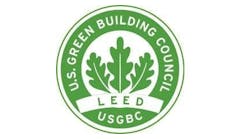When building owners were asked what matters most in roofing materials, they ranked service life and lifecycle cost first and second. Initial cost ranked ninth out of 10.
This finding from a study by Ducker Research Company on the lifecycle costs of low-slope roofing cut across the three major roofing material categories: metal, asphalt and single-ply.[i] The message is clear: building owners are looking for a roofing system that lasts for many years and saves money over the long term.
Experience demonstrates that a building’s roof system can account for 10% of total construction costs but up to 60% of total lifecycle maintenance costs. Of course, the lifecycle costs of roofing go beyond material and maintenance. Broadly speaking, the choice of a roofing system impacts energy consumption in categories including heating and cooling, lighting, feasibility of roof-mounted renewable energy, potential for government tax incentives and utility rebates, as well as the market value of the building itself.
Research and product testing, combined with in-the-field experience spanning four decades, make a strong case for standing-seam metal roof systems. These roof systems offer durability, low maintenance cost, and adaptability to current trends driving energy efficiency and sustainability in the commercial building sector.
1) Save on Lifecycle Costs A Ducker Research Company study drew from case studies involving 36 roofing systems across the United States. The study covered office, retail, institutional, and warehouse/industrial buildings to include 12 metal, 12 asphalt and 12 single-ply roofs, averaging 92,000 square feet.
An earlier study that analyzed overall life expectancy found that metal roofs had an expected service life of 40 years vs. 23 years for asphalt and 20 for single-ply. The more recent study placed the lifecycle cost of metal roofs at 30 cents per square foot per year, compared with 37 cents for asphalt and 57 cents for single-ply based on expected service life. Owners reported spending 3.5% of total installed costs on maintenance for metal roofs vs. 28.5% for asphalt and 19% for single-ply over the expected service life.
Inherent qualities of metal roofs help account for these differences. Today’s standing-seam metal roof systems are proven to deliver weathertight performance for 40 years or more. The roof acts as a monolithic steel surface covering the entire building.
Attributes of these roofs can include:
- Roof clips that securely hold the roof panels to the structural members, with the flexibility for the panels to move with expansion and contraction caused by daily and seasonal temperature changes
- Weathertight sealing, with 180 degrees of the roof panel seam field-rolled to complete a 360-degree Pittsburgh double-lock seam, also impregnated with sealant
- Factory punching to ensure proper alignment of the roof panels, paired with heavy-duty fasteners
- Splices staggered to prevent exposed seams and leak points that are located directly over supporting steel to withstand foot traffic and snow loads
- Steel-rod bracing that will not stretch or sag, allowing the roof to retain its original strength and tightness
- Roof curbs and openings engineered at the factory and fasteners concealed inside the curbs to eliminate leaks
These metal roofs in many cases can be applied directly over aging asphalt, single-ply, or metal roofs to restore weathertight conditions and provide long-term building protection.PageBreak
2) Conserve Energy Although durability and low maintenance help keep long-term costs down, a sound roof design also helps conserve energy and generate substantial savings over a building’s life. As part of a tested assembly, a standing-seam roof system can result in energy savings of up to 40%.
Energy efficiency in buildings is not just desirable — it is becoming mandatory with more stringent building and energy codes. ASHRAE Standard 90.1 and the latest version of IECC signal a new era of accountability for building efficiency.
The roof is often the least energy efficient part of the building envelope. Heating and cooling typically consume about 30% of a building’s energy, and half of that results from heated or cooled air lost through the roof. A well-designed and properly installed roof helps reduce those losses and maintain more consistent interior temperatures.
Thicker insulation is part of the answer. However, when applied to conventional built-up roofs, the added insulation may negate the energy savings by speeding deterioration of the roof surface. Metal roofs, on the other hand, can accommodate more insulation — to an R-value of 40 with no effect on roof service life.
Better still, metal roofing assemblies are available that have achieved these values through testing to meet code requirements. Guarded Hot Box tests for U-factor are proven compliant with the IECC and ASHRAE standards.
3) Reduce Air Conditioning Metal roof systems can also function as cool roofs, helping owners save money by repelling, rather than absorbing, the sun’s heat during summer. This can ultimately reduce air conditioning costs.
Roofs painted in light colors reflect more solar radiation and reduce the roof temperature. Infrared reflective pigments enable roofs to reflect significant sunlight even when darker paints are used. In addition, on cloudy days or after sunset, metal roofs give up their heat faster than other roofing materials.
Cool metal roofs perform well even when compared with white membrane roofing. A study at the Oak Ridge National Laboratory in Tennessee found a metal roof system more effective than conventional roofs in reflecting the sun’s rays and in preventing solar heat transfer into a building.
The effect of cool roofing on buildings can be dramatic. For example, the Heat Island Group at Lawrence Berkeley National Laboratory in California has reported that reflective roofing can directly save up to 40% in cooling and heating costs.
Cool roofs are gaining popularity in part because governments offer rebates and energy credits to contractors and building owners to change dark, absorptive roofing materials to cool roof systems. Some utilities also offer rebates to building owners using cool metal roofs that help reduce peak energy demand during the cooling season.
In addition, cool roofs have the added benefit of mitigating the urban heat island effect, thus helping reduce smog formed from the reaction of nitrogen oxides and volatile organic chemicals.[ii]PageBreak
4) Decrease Lighting Needs Energy savings from metal roofing also extending to lighting. Skylights and other roof-installed devices can strongly contribute to daylighting. One study found that an economically optimum toplighting system (defined as using skylights with electronic lighting controls to turn off electric lights when not needed) saved 35-55% of annual lighting energy, with smaller impacts on heating and cooling energy. The same study determined that toplighting could save 11-32 cents per square foot per year, depending on climate and building type.[iii]
The latest daylighting devices have marked advantages over traditional flat skylights. These domed units have prismatic embossing that collects up to three times more of the sun’s rays earlier and later in the day, when the sun angle is low. Prisms refract sunlight into microbeams that transmit more light into the building, without glare, hot spots or UV damage. The devices have been shown to reduce electric lighting costs by up to 70% when integrated with lighting controls, providing a return on investment in as little as three to five years.
The units can reduce the number of total roof penetrations by 30% due to their higher light transmittance. A self-curbing design avoids the inherent risk of leaks around flashings found in the traditional curbs used on conventional skylights. The system is integrated into the metal panel seams to minimize the amount of contact with water flow overall.
5) Add Sustainability Renewable energy plays a growing role in buildings, and the potential for rooftop renewables is great. The National Renewable Energy Laboratory in Colorado has estimated that some 67 percent of the nation’s commercial buildings have rooftops available for solar water heating.[iv] Whether for thermal energy or electricity, quality metal roofs accommodate solar panels without requiring penetrations that could compromise roof integrity.
Steel roofing is also 100% recyclable, and the steel in a new or retrofit roof will contain 25-28% recycled content. Conventional roofing materials, on the other hand, are frequently disposed of in landfills and sometimes classified as hazardous waste.PageBreak
6) Improve Property Value Roofs that improve energy performance not only save on monthly utility bills, but they can also help buildings command higher rents and selling prices. Markets are taking notice that energy efficient buildings carry economic advantages. For example, studies show that rent premiums for ENERGY STAR-certified office buildings can range from 5-8.5%, while resale premiums for such buildings can range from 13-26%.[v],[vi],[vii],[viii]
Metal roofing systems can add value to buildings and renovations on many levels, from proven longevity and reliable weather protection to energy code compliance, operational savings, carbon emission reduction, enhanced occupant comfort, and higher property values.
Rodger Russ is the North American sales manager for the roof division of Butler Manufacturing, which provides design-build construction solutions and commercial building technology. He has more than 27 years of diverse experience since starting in the sheet metal trade in Chicago. He can be reached at [email protected].
[i]Ducker Research Company. Low Slope Roofing Life Cycle Cost Analysis. May 2005.
[ii]Kriner S. Architects turn to cool metal roofing in North America. Available at: http://www.coolmetalroofing.org/elements/uploads/casestudies/TMI_CaseStudy_26.pdf. Accessed May 15, 2013.
[iii]TIAX LLC, for U.S. Department of Energy. Commercial Building Toplighting: Energy Saving Potential and Potential Paths Forward. Available at: http://apps1.eere.energy.gov/buildings/publications/pdfs/commercial_initiative/toplighting_final_report.pdf. Accessed May 15, 2013.
[iv]Denholm P. National Renewable Energy Laboratory. The Technical Potential of Solar Water Heating to Reduce Fossil Fuel Use and Greenhouse Gas Emissions in the United States. Available at: http://www.nrel.gov/docs/fy07osti/41157.pdf. Accessed May 15, 2013.
[v]Fuerst F, McAllister PM. New Evidence on the Green Building Rent and Price Premium. Available at: http://papers.ssrn.com/sol3/papers.cfm?abstract_id=1372440. Accessed May 15, 2013.
[vi]CoStar Group. Commercial Real Estate and the Environment. Available at: http://www.costar.com/uploadedFiles/Partners/CoStar-Green-Study.pdf. Accessed May 15, 2013.
[vii]Eichholtz P, Kok N, Quiqley JM. The Economics of Green Building. Available at: http://cbey.research.yale.edu/uploads/Environmental%20Economics%20Seminar/EKQ%20082010%20JMQ%20(2).pdf. Accessed May 15, 2013.
[viii]McGraw Hill Construction. Green Building Retrofit & Renovation. Available at: http://mts.sustainableproducts.com/Capital_Markets_Partnership/BusinessCase/MHC%20Green%20Building%20Retrofit%20%26%20Renovation%20SMR%20(2009).pdf. Accessed May 15, 2013.


